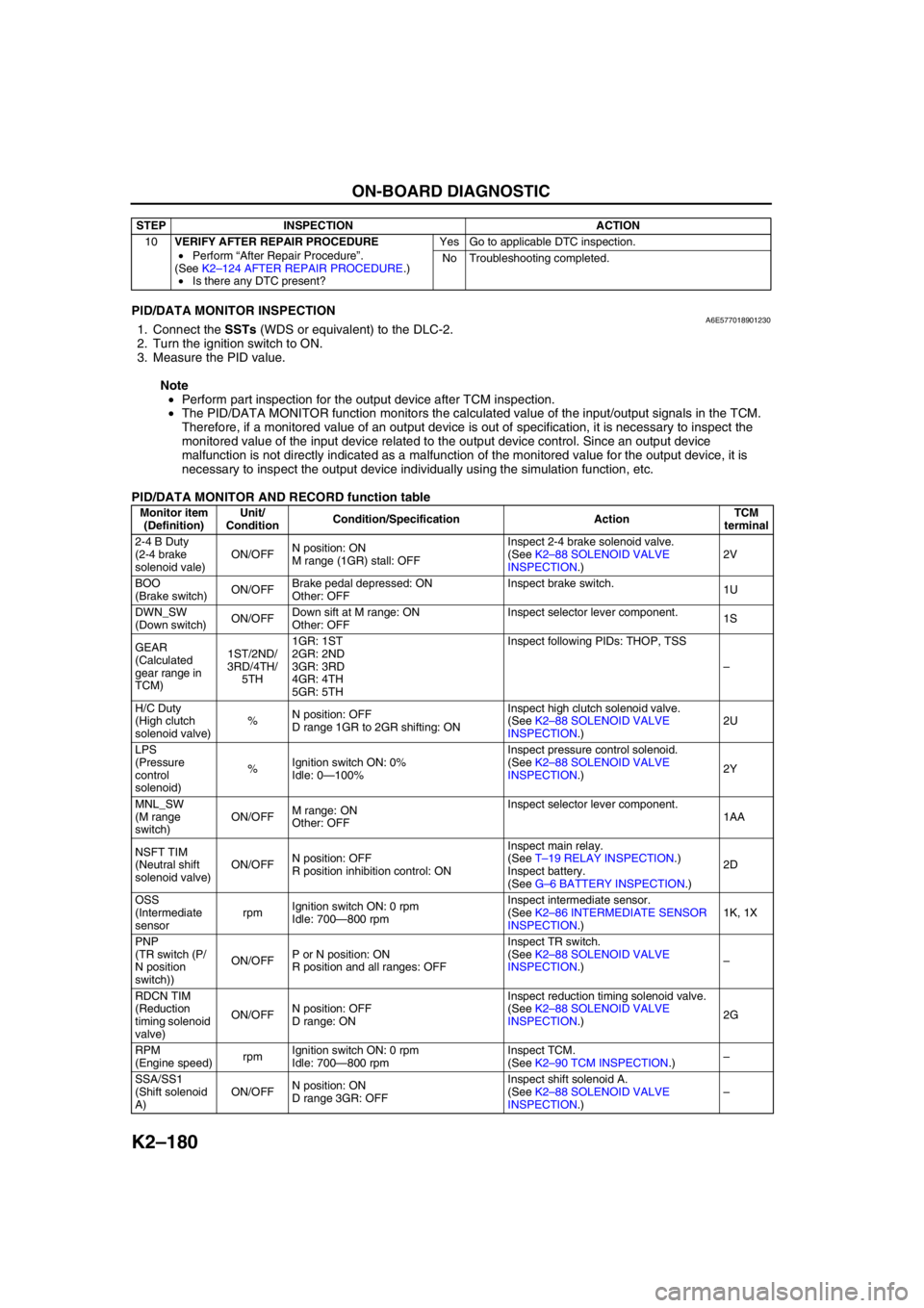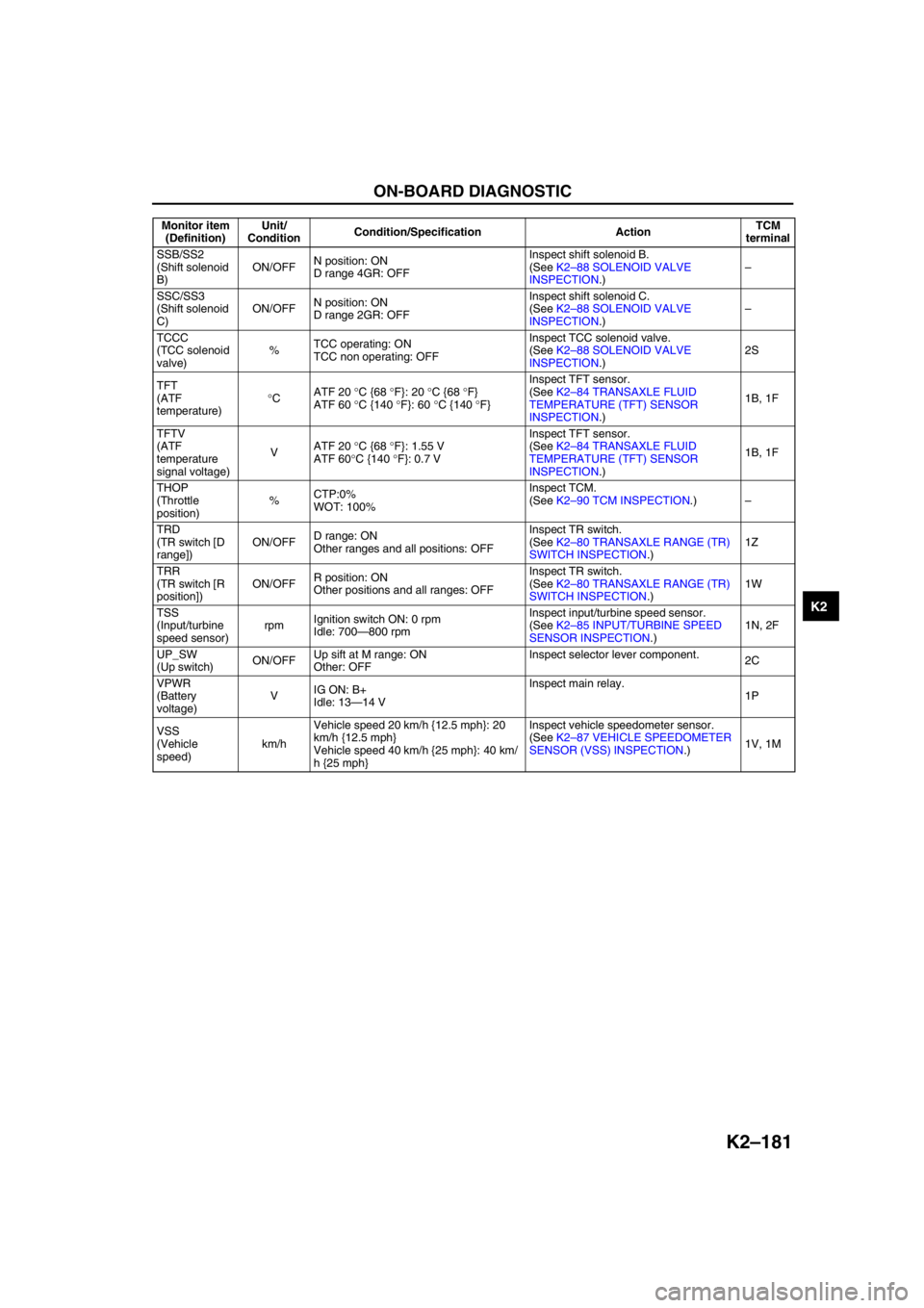sensor MAZDA 6 2002 Workshop Manual Suplement
[x] Cancel search | Manufacturer: MAZDA, Model Year: 2002, Model line: 6, Model: MAZDA 6 2002Pages: 909, PDF Size: 17.16 MB
Page 557 of 909

K2–142
ON-BOARD DIAGNOSTIC
End Of SieDTC P0740A6E577018901212
Diagnostic procedure
12VERIFY TROUBLESHOOTING OF DTC P0720
COMPLETED
•Make sure to reconnect all disconnected
connectors.
•Clear DTC from memory using WDS or
equivalent.
•Drive vehicle with vehicle speed 40 km/h {25
mph} or above for 2 second or more
•Is same DTC present?Yes Replace TCM, then go to next step.
(See K2–96 TCM REMOVAL/INSTALLATION.)
No Go to next step.
13VERIFY AFTER REPAIR PROCEDURE
•Perform “After Repair Procedure”.
(See K2–124 AFTER REPAIR PROCEDURE.)
•Is there any DTC present?Yes Go to applicable DTC inspection.
No Troubleshooting completed. STEP INSPECTION ACTION
DTC P0740 TCC system malfunction
DETECTION
CONDITION•RPM difference between crankshaft (engine speed signal) and reverse clutch drum (input/turbine speed
sensor signal) exceeds the pre-programmed value.
Diagnostic support note:
•This is continuous monitor (CCM).
•MIL illuminates if TCM detects the above malfunction conditions in two consecutive drive cycles.
•PENDING CODE is available.
•FREEZE FRAME DATA is available.
•AT warning light does not indication.
•DTC is stored in TCM memory.
POSSIBLE
CAUSE•ATF level low.
•Deteriorated ATF.
•TCC solenoid valve and pressure control solenoid stuck.
•Line pressure low.
•Oil pump malfunction.
•Control valve stuck
•Torque convert clutch malfunction
•TCM malfunction.
STEP INSPECTION ACTION
1VERIFY FREEZE FRAME DATA HAS BEEN
RECORDED
•Has FREEZE FRAME PID DATA been
recorded?Yes Go to next step.
No Record FREEZE FRAME PID DATA on repair order, then
go to next step.
2VERIFY RELATED REPAIR INFORMATION
AVAILABILITY
•Check for related Service Bulletins and/or on-
line repair information availability.
•Is any related repair information available?Yes Perform repair or diagnosis according to available repair
information.
•If vehicle is not repaired, go to next step.
No Go to next step.
3CHECK ATF CONDITION
•Turn ignition key to OFF.
•Check ATF condition.
—Clear red: Normal
—Milky: Water mixed in fluid
—Reddish brown: Deteriorated ATF
•Is it okay?
(See K2–78 Automatic Transaxle Fluid (ATF)
Condition Inspection.)Yes Go to next step.
No If ATF color milky or reddish brown, replace ATF, then go to
Step 5.
(See K2–80 AUTOMATIC TRANSAXLE FLUID (ATF)
REPLACEMENT.)
4CHECK ATF LEVEL
•Start engine.
•Warm up ATX.
•Is ATF level within specification?
(See K2–79 Automatic Transaxle Fluid (ATF)
Level Inspection.)Yes Go to next step.
No Adjust ATF level, then go to Step 9.
(See K2–79 Automatic Transaxle Fluid (ATF) Level
Inspection.)
Page 587 of 909

K2–172
ON-BOARD DIAGNOSTIC
DTC P0791A6E577018901227
DTC P0791 Intermediate sensor circuit malfunction (open/short)
DETECTION
CONDITION•Rotation speed of output gear (intermediate sensor) is low when vehicle speed and engine speed exceed
the preprogrammed value.
Diagnostic support note:
•This is continuous monitor (CCM).
•MIL illuminates if TCM detects the above malfunction condition.
•PENDING CODE is not available.
•FREEZE FRAME DATA is available.
•AT warning light indication.
•DTC is stored in TCM memory.
POSSIBLE
CAUSE•Intermediate sensor malfunction.
•Short to ground between intermediate sensor terminal B and TCM terminal 1K
•Short to ground between intermediate sensor terminal A and TCM terminal 1X
•Open circuit between intermediate sensor terminal B and TCM terminal 1K
•Open circuit between intermediate sensor terminal A and TCM terminal 1X
•Damaged connectors between intermediate sensor and TCM.
•TCM malfunction.
D
B
AC
1K
1X CDTCM
AT X
TCM
HARNESS SIDE CONNECTOR
TERMINAL COMPONENT
NO.2(8-PIN)
HARNESS SIDE CONNECTOR
COUPLER COMPONENT
(8-PIN)
PART SIDE CONNECTORINTERMEDIATE SENSOR
HARNESS SIDE CONNECTOR INTERMEDIATE
SENSOR
Page 588 of 909

ON-BOARD DIAGNOSTIC
K2–173
K2
Diagnostic procedure
STEP INSPECTION ACTION
1VERIFY FREEZE FRAME DATA HAS BEEN
RECORDED
•Has FREEZE FRAME PID DATA been
recorded?Yes Go to next step.
No Record FREEZE FRAME PID DATA on repair order, then
go to next step.
2VERIFY RELATED REPAIR INFORMATION
AVAILABILITY
•Check for related Service Bulletins and/or on-
line repair information availability.
•Is any related repair information available?Yes Perform repair or diagnosis according to available repair
information.
•If vehicle is not repaired, go to next step.
No Go to next step.
3INSPECT TERMINAL COMPONENT NO.2 (8-
PIN) CONNECTOR FOR POOR CONNECTION
•Turn ignition key to OFF.
•Disconnect terminal component No.2 (8-pin)
connector.
•Check for poor connection (damaged, pulled-
out terminals, corrosion, etc.).
•Are terminals okay?Yes Go to next step.
No Repair or replace terminals, then go to Step 12.
4INSPECT INTERMEDIATE SENSOR
RESISTANCE
•Measure resistance between terminal
component No.2 (8-pin) (transaxle case side).
•Is resistance within 513—627 ohms between
terminal component No.2 (8-pin) terminal C
and D (transaxle case side)?Yes Go to next step.
No Go to Step 8
5INSPECT TCM CONNECTOR FOR POOR
CONNECTION
•Disconnect TCM connector.
•Check for poor connection (damaged, pulled-
out terminals, corrosion, etc.).
•Are terminals okay?Yes Go to next step.
No Repair terminals, then go to Step 12.
6INSPECT TERMINAL COMPONENT NO.2 (8-
PIN) CIRCUIT FOR OPEN
•Check terminal component No.2 (8-pin)
terminals (harness-side) and TCM terminals
(harness-side).
—C and 1K
—D and 1X
•Is there continuity?Yes Go to next step.
No Repair or replace harness, then go to Step 12.
7INSPECT TERMINAL COMPONENT NO.2 (8-
PIN) CIRCUIT FOR SHORT TO GROUND
•Check terminal component No.2 (8-pin)
terminal (harness-side) and body ground.
—C and body ground
—D and body ground
•Is there any continuity?Yes Repair or replace harness, then go to Step 12.
No Go to Step 12.
8INSPECT COUPLER COMPONENT (8-PIN)
CONNECTOR FOR POOR CONNECTION
•Disassemble the control valve body cover.
•Disconnect coupler component (8-pin)
connector.
•Check for poor connection (damaged, pulled-
out terminals, corrosion, etc.).
•Are terminals okay?Yes Go to next step.
No Repair terminals, then go to Step 12.
9INSPECT INTERMEDIATE SENSOR
RESISTANCE
•Measure resistance between coupler
component (8-pin).
•Is resistance within 513—627 ohms between
coupler component (8-pin) terminal D and C
(part side)?Yes Repair or replace coupler component, then go to Step 12.
No Go to next step.
Page 589 of 909

K2–174
ON-BOARD DIAGNOSTIC
End Of Sie
10INSPECT INTERMEDIATE SENSOR
CONNECTOR FOR POOR CONNECTION
•Disassemble the transaxle.
•Disconnect intermediate sensor connector.
•Check for poor connection (damaged, pulled-
out terminals, corrosion, etc.).
•Are terminals okay?Yes Go to next step.
No Repair terminals, then go to Step 12.
11INSPECT INTERMEDIATE SENSOR
RESISTANCE
•Measure resistance between intermediate
sensor.
•Is resistance within 513—627 ohms between
intermediate sensor connector terminal A and
B (part side)?Yes Repair or replace coupler component, then go to next step.
No Replace intermediate sensor, then go to next step.
12VERIFY TROUBLESHOOTING OF DTC P0715
COMPLETED
•Make sure to reconnect all disconnected
connectors.
•Clear DTC from memory using WDS or
equivalent.
•Drive vehicle with vehicle speed 40 km/h {25
mph} or above and engine speed 1500 rpm or
above for 2 second or more
•Repeat Step ii two times.
•Is same DTC present?Yes Replace TCM, then go to next step.
(See K2–96 TCM REMOVAL/INSTALLATION.)
No Go to next step.
13VERIFY AFTER REPAIR PROCEDURE
•Perform “After Repair Procedure”.
(See K2–124 AFTER REPAIR PROCEDURE.)
•Is there any DTC present?Yes Go to applicable DTC inspection.
No Troubleshooting completed. STEP INSPECTION ACTION
Page 595 of 909

K2–180
ON-BOARD DIAGNOSTIC
End Of SiePID/DATA MONITOR INSPECTIONA6E5770189012301. Connect the SSTs (WDS or equivalent) to the DLC-2.
2. Turn the ignition switch to ON.
3. Measure the PID value.
Note
•Perform part inspection for the output device after TCM inspection.
•The PID/DATA MONITOR function monitors the calculated value of the input/output signals in the TCM.
Therefore, if a monitored value of an output device is out of specification, it is necessary to inspect the
monitored value of the input device related to the output device control. Since an output device
malfunction is not directly indicated as a malfunction of the monitored value for the output device, it is
necessary to inspect the output device individually using the simulation function, etc.
PID/DATA MONITOR AND RECORD function table
10VERIFY AFTER REPAIR PROCEDURE
•Perform “After Repair Procedure”.
(See K2–124 AFTER REPAIR PROCEDURE.)
•Is there any DTC present?Yes Go to applicable DTC inspection.
No Troubleshooting completed. STEP INSPECTION ACTION
Monitor item
(Definition)Unit/
ConditionCondition/Specification ActionTCM
terminal
2-4 B Duty
(2-4 brake
solenoid vale)ON/OFFN position: ON
M range (1GR) stall: OFFInspect 2-4 brake solenoid valve.
(See K2–88 SOLENOID VALVE
INSPECTION.)2V
BOO
(Brake switch)ON/OFFBrake pedal depressed: ON
Other: OFFInspect brake switch.
1U
DWN_SW
(Down switch)ON/OFFDown sift at M range: ON
Other: OFFInspect selector lever component.
1S
GEAR
(Calculated
gear range in
TCM)1ST/2ND/
3RD/4TH/
5TH1GR: 1ST
2GR: 2ND
3GR: 3RD
4GR: 4TH
5GR: 5THInspect following PIDs: THOP, TSS
–
H/C Duty
(High clutch
solenoid valve)%N position: OFF
D range 1GR to 2GR shifting: ONInspect high clutch solenoid valve.
(See K2–88 SOLENOID VALVE
INSPECTION.)2U
LPS
(Pressure
control
solenoid)%Ignition switch ON: 0%
Idle: 0—100%Inspect pressure control solenoid.
(See K2–88 SOLENOID VALVE
INSPECTION.)2Y
MNL_SW
(M range
switch)ON/OFFM range: ON
Other: OFFInspect selector lever component.
1AA
NSFT TIM
(Neutral shift
solenoid valve)ON/OFFN position: OFF
R position inhibition control: ONInspect main relay.
(See T–19 RELAY INSPECTION.)
Inspect battery.
(See G–6 BATTERY INSPECTION.)2D
OSS
(Intermediate
sensorrpmIgnition switch ON: 0 rpm
Idle: 700—800 rpmInspect intermediate sensor.
(See K2–86 INTERMEDIATE SENSOR
INSPECTION.)1K, 1X
PNP
(TR switch (P/
N position
switch))ON/OFFP or N position: ON
R position and all ranges: OFFInspect TR switch.
(See K2–88 SOLENOID VALVE
INSPECTION.)–
RDCN TIM
(Reduction
timing solenoid
valve)ON/OFFN position: OFF
D range: ONInspect reduction timing solenoid valve.
(See K2–88 SOLENOID VALVE
INSPECTION.)2G
RPM
(Engine speed)rpmIgnition switch ON: 0 rpm
Idle: 700—800 rpmInspect TCM.
(See K2–90 TCM INSPECTION.)–
SSA/SS1
(Shift solenoid
A)ON/OFFN position: ON
D range 3GR: OFFInspect shift solenoid A.
(See K2–88 SOLENOID VALVE
INSPECTION.)–
Page 596 of 909

ON-BOARD DIAGNOSTIC
K2–181
K2
End Of Sie
SSB/SS2
(Shift solenoid
B)ON/OFFN position: ON
D range 4GR: OFFInspect shift solenoid B.
(See K2–88 SOLENOID VALVE
INSPECTION.)–
SSC/SS3
(Shift solenoid
C)ON/OFFN position: ON
D range 2GR: OFFInspect shift solenoid C.
(See K2–88 SOLENOID VALVE
INSPECTION.)–
TCCC
(TCC solenoid
valve)%TCC operating: ON
TCC non operating: OFFInspect TCC solenoid valve.
(See K2–88 SOLENOID VALVE
INSPECTION.)2S
TFT
(ATF
temperature)°CATF 20 °C {68 °F}: 20 °C {68 °F}
ATF 60 °C {140 °F}: 60 °C {140 °F}Inspect TFT sensor.
(See K2–84 TRANSAXLE FLUID
TEMPERATURE (TFT) SENSOR
INSPECTION.)1B, 1F
TFTV
(ATF
temperature
signal voltage)VATF 20 °C {68 °F}: 1.55 V
ATF 60°C {140 °F}: 0.7 VInspect TFT sensor.
(See K2–84 TRANSAXLE FLUID
TEMPERATURE (TFT) SENSOR
INSPECTION.)1B, 1F
THOP
(Throttle
position)%CTP:0%
WOT: 100%Inspect TCM.
(See K2–90 TCM INSPECTION.)–
TRD
(TR switch [D
range])ON/OFFD range: ON
Other ranges and all positions: OFFInspect TR switch.
(See K2–80 TRANSAXLE RANGE (TR)
SWITCH INSPECTION.)1Z
TRR
(TR switch [R
position])ON/OFFR position: ON
Other positions and all ranges: OFFInspect TR switch.
(See K2–80 TRANSAXLE RANGE (TR)
SWITCH INSPECTION.)1W
TSS
(Input/turbine
speed sensor)rpmIgnition switch ON: 0 rpm
Idle: 700—800 rpmInspect input/turbine speed sensor.
(See K2–85 INPUT/TURBINE SPEED
SENSOR INSPECTION.)1N, 2F
UP_SW
(Up switch)ON/OFFUp sift at M range: ON
Other: OFFInspect selector lever component.
2C
VPWR
(Battery
voltage)VIG ON: B+
Idle: 13—14 VInspect main relay.
1P
VSS
(Vehicle
speed)km/hVehicle speed 20 km/h {12.5 mph}: 20
km/h {12.5 mph}
Vehicle speed 40 km/h {25 mph}: 40 km/
h {25 mph}Inspect vehicle speedometer sensor.
(See K2–87 VEHICLE SPEEDOMETER
SENSOR (VSS) INSPECTION.)1V, 1M Monitor item
(Definition)Unit/
ConditionCondition/Specification ActionTCM
terminal
Page 600 of 909

TROUBLESHOOTING
K2–185
K2
Quick Diagnosis Chart
Vehicle dose not move in D range, or in R position X X
X
X
X
X
X
X
X
X
XX X
XX
XX
XX
XX
X X X
X
XX X
XX
X XXXXX
XX X
XX
XX X X
X
X
X XX
X
XX
X
X
XX
X
XXX
X
XXX
X
X X XX
X
XXXX XX
X
XX
X
X X
XX XX
X
X
X 1
Excessive creep 4
No creep at all 5
Low maximum speed and poor acceleration 6
No shifting 7
Does not shift to fifth gear (5GR) 8
Abnormal shifting 9
Frequent shifting 10
Shift point is high or low 11
Torque converter clutch (TCC) non-operation 12
No kickdown 13
Engine flares up or slips when upshifting or downshifting 14
Engine flares up or slip when accelerating vehicle 15
Judder upon torque converter clutch (TCC) operation 16
Excessive shift shock from N to D or N to R position/range 17
Excessive shift shock on torque converter clutch (TCC) 19
No engine braking in 1GR position of M range 22
Transaxle overheats 23
Engine stalls when shifted to D range, or in R position 24
Engine stalls when driving at slow speeds or stopping 25
Starter does not work 26Excessive shift shock is given when upshifting and
downshifting 18
Noise occurs at idle when vehicle is stopped in all
positions/ranges 20
Noise occurs at idle when vehicle is stopped in D
range, or in R position 21
Gear position indicator light illuminates in D range or P, N,
R positions 28Gear position indicator light does not illuminate in M range
Electrical system components
ATX outer parts 27
Does not shift up in M range
29
Does not shift down in M range
Symptom item
Cause of trouble
Selector lever is misadjisted
Not within line pressure specification
Idle speed is misadjusted
IG timing is misadjusted
TR switch is misadjusted
Open/short
Abnormal signal is inputed
Abnormal signal is inputed Signal is not inputed
Signal is not inputed
Abnormal signal is inputed Signal is not inputed
Abnormal signal is inputed Signal is not inputed
Abnormal signal is inputed Signal is not inputed
Abnormal signal is inputed Signal is not inputed
Abnormal signal is inputed
Abnormal signal is inputed Signal is not inputedCAN signal
CAN signal Engine speed signal
Vehicle speedometer sensor
Input/turbine speed sensor
Intermediate sensor
D range switch
M range switch
Up switch
Down switch
Throttle opening
30Vehicle moves in N position 2
Vehicle moves in P position, or parking gear does not
disengage when P is disengaged 3
X X X
X X X
X
X
A6E5780W001
Page 601 of 909

K2–186
TROUBLESHOOTING
CAN signal
Vehicle dose not move in D range, or in R position
X
XXX X
X
X X
X
XX
X
X
X
X
X
XX
XX
XX
XXX
XX
XX
X
XXX X
XX X
XX X
XX X
XXX
XX
X
XX
X XX XX
X
XX
XX
X XX
X XXXX
XXXX
XXXXX XX XXX
X
X
XX
X
X
X
X
X
X
X
X
X
X X
X
X
X X
XXX
XX
XX X X
X 1
Excessive creep 4
No creep at all 5
Low maximum speed and poor acceleration 6
No shifting 7
Does not shift to fifth gear (5GR) 8
Abnormal shifting 9
Frequent shifting 10
Shift point is high or low 11
Torque converter clutch (TCC) non-operation 12
No kickdown 13
Engine flares up or slips when upshifting or downshifting 14
Engine flares up or slip when accelerating vehicle 15
Judder upon torque converter clutch (TCC) operation 16
Excessive shift shock from N to D or N to R position/range 17
Excessive shift shock on torque converter clutch (TCC) 19
No engine braking in 1GR position of M range 22
Transaxle overheats 23
Engine stalls when shifted to D range, or in R position 24
Engine stalls when driving at slow speeds or stopping 25
Starter does not work 26Excessive shift shock is given when upshifting and
downshifting 18
Noise occurs at idle when vehicle is stopped in all
positions/ranges 20
Noise occurs at idle when vehicle is stopped in D
range, or in R position 21
Gear position indicator light illuminates in D range or P, N,
R positions 28Gear position indicator light does not illuminate in M range
Electrical system components
ATX inner parts
ATX outer parts
Hydraulic system
components
Control valve body 27
Does not shift up in M range
29
Does not shift down in M rangeSymptom item
Cause of trouble
Open/short
Malfunction signal is inputed Signal is inputed
Open/short
Open/short Open/short
Open/short
Open/short
Open/short
Open/short
Open/short Open/short
Open/short
Open/short Open/short
Control valve spool is not operating properly ATF amount
2-4 brake accumulator is not operating properly Low clutch solenoid accumulator is not operating properly
Direct clutch accumulator is not operating properly High clutch accumulator is not operating properly2-4 brake solenoid valve Pressure control solenoid
TCC solenoid valve
High clutch solenoid valve TFT sensor N-D select
Transaxle range switch
Power supply, GND
Shift solenoid A
Shift solenoid B
Shift solenoid C
Neutral shift solenoid valve
Reducation timing solenoid
GND return line
30Vehicle moves in N position 2
Vehicle moves in P position, or parking gear does not
disengage when P is disengaged 3
A6E5780W002
Page 603 of 909

K2–188
TROUBLESHOOTING
NO.1 VEHICLE DOES NOT MOVE IN D RANGE, OR IN R POSITIONA6E578001030204
Diagnostic procedure
End Of SieNO.2 VEHICLE MOVES IN N POSITIONA6E578001030205
1 Vehicle does not move in D range, or in R position
DESCRIPTION•Vehicle does not move when accelerator pedal depressed.
POSSIBLE
CAUSE•If vehicle does not move in D range or R position, basically, malfunction is in ATX. (Vehicle will move
even with a malfunction in TCM.) Since a malfunction in sensor circuit or output circuit is cause of
malfunction in ATX, inspect sensors, output circuit, and related harnesses.
—Clutch slipped, worn (D range-Low clutch, Low one-way clutch, Reduction one-way clutch, R
position-Reverse clutch, Low and reverse brake, Reduction brake)
•Line pressure low
•Malfunction of shift solenoid A, B, or C
•Malfunction of sensor ground
•Malfunction of body ground
•Malfunction of control valve body
—Malfunction of selector lever
—Parking mechanism not properly operated
—Malfunction of torque converter
Note
•Before following troubleshooting steps, make sure that Automatic Transaxle On-Board Diagnostic
and Automatic Transaxle Basic Inspection are conducted.
STEP INSPECTION ACTION
1•With vehicle stopped on a flat, paved road
and engine off, does vehicle move when
pushed? (in D ranges or N, R positions and
brake released)Yes Go to next step.
No Inspect for parking mechanism.
(See ATX Workshop Manual.)
2•Start engine.
•Does vehicle move when selector lever in
between N position and D range?Yes Inspect or adjust selector lever.
(See K2–117 SELECTOR LEVER INSPECTION.)
(See K2–118 SELECTOR CABLE ADJUSTMENT.)
No Go to next step.
3•Stop engine.
•Inspect pressure control solenoid circuit.
•Is it okay?Yes•Overhaul control valve body and repair or replace any
defective parts.
(See ATX Workshop Manual.)
—If problem remains, replace or overhaul transaxle and
repair or replace any defective parts.
(See K2–99 AUTOMATIC TRANSAXLE AND
TRANSFER REMOVAL/INSTALLATION.)
(See ATX workshop Manual.)
No•Inspect for pressure control solenoid mechanical stuck.
(See K2–88 SOLENOID VALVE INSPECTION.)
—If pressure control solenoid okay, inspect for open or
short circuit between TCM connector terminal 2Y and
pressure control solenoid connector terminal D.
4•Verify test results.
—If okay, return to diagnostic index to service any additional symptoms.
—If malfunction remains, inspect related Service Informations and perform repair or diagnosis.
—If vehicle repaired, troubleshooting completed.
—If vehicle not repaired or additional diagnostic information not available, replace TCM.
2 Vehicle moves in N position
DESCRIPTION•Vehicle creeps in N position.
•Vehicle creeps if brake pedal not depressed in N position.
POSSIBLE
CAUSE•If vehicle moves in N position, basically, malfunction is in ATX. Since a malfunction in sensor circuit or
output circuit is cause of malfunction in ATX, inspect sensors, output circuit, and related harnesses.
—Clutch burned (Low clutch, Low one-way clutch, Low and reverse brake)
•Line pressure low
•Malfunction of control valve body
—Selector lever position disparity (Although the selector indicator shows N position, hydraulic circuit
shows D range or R position)
Note
•Before following troubleshooting steps, make sure that Automatic Transaxle On-Board Diagnostic
and Automatic Transaxle Basic Inspection are conducted.
Page 605 of 909

K2–190
TROUBLESHOOTING
Diagnostic procedure
End Of SieNO.6 LOW MAXIMUM SPEED AND POOR ACCELERATIONA6E578001030209
Diagnostic procedure
STEP INSPECTION ACTION
1•Does vehicle creep in P and/or N position? Yes Inspect or adjust the selector lever.
(See K2–117 SELECTOR LEVER INSPECTION.)
(See K2–118 SELECTOR CABLE ADJUSTMENT.)
No Go to next step.
2•Stop engine.
•Inspect pressure control solenoid circuit.
•Is it okay?Yes Go to next step.
No•Inspect for pressure control solenoid mechanical stuck.
(See K2–88 SOLENOID VALVE INSPECTION.)
—If pressure control solenoid okay, inspect for open or
short circuit between TCM connector terminal 2Y and
pressure control solenoid connector terminal D.
3•Remove torque converter.
•Inspect torque converter.
(See ATX Workshop Manual.)
•Is torque converter okay?Yes•Overhaul control valve body and repair or replace any
defective parts.
(See ATX Workshop Manual.)
—If problem remains, replace or overhaul transaxle and
repair or replace any defective parts.
(See K2–99 AUTOMATIC TRANSAXLE AND
TRANSFER REMOVAL/INSTALLATION.)
(See ATX Workshop Manual.)
No Replace torque converter.
4•Verify test results.
—If okay, return to diagnostic index to service any additional symptoms.
—If malfunction remains, inspect related Service Informations and perform repair or diagnosis.
—If vehicle repaired, troubleshooting completed.
—If vehicle not repaired or additional diagnostic information not available, replace TCM.
6 Low maximum speed and poor acceleration
DESCRIPTION•Vehicle acceleration poor at start.
•Delayed acceleration when accelerator pedal depressed while driving.
POSSIBLE
CAUSE•If clutch is stuck or does not stay in 4GR, malfunction is in engine circuit.
—Clutch slipped, burned
•Line pressure low
•Incorrect throttle position signal
•Malfunction of VSS
•Malfunction of input/turbine speed sensor
•Malfunction of sensor ground
•Malfunction of shift solenoids A, B, or C
•Malfunction of body ground
•Malfunction of control valve body
—Transaxle fixed in 4GR (Operation of fail-safe function)
•Short or open circuit in wiring
•Poor connection of connector
•Electronic parts of output and input system malfunction are malfunctioning
—Insufficient starting torque (Suspected when in-gear condition, shift control and engine circuit are
normal)
•Malfunction of torque converter (Poor operation, sticking)
—Engagement of TCC operation range (Operation of fail-safe function)
•Malfunction of TFT sensor (Short or open circuit)
Note
•Before following troubleshooting steps, make sure that Automatic Transaxle On-Board Diagnostic
and Automatic Transaxle Basic Inspection are conducted.
STEP INSPECTION ACTION
1•With ignition switch at ON, does gear
position indicator light indication correspond
to selector lever position?Yes Go to next step.
No Go to symptom troubleshooting No.27 “Gear position
indicator light does not illuminate in M range”, or No.28
“Gear position indicator light illuminates in D range or P, N,
R position”.
2•Go to symptom troubleshooting No.12 “Lack/
loss of power-acceleration/cruise”.
(See Section F.)
•Does engine control system okay?Yes Go to next step.
No Repair or replace any defective parts according to
inspection results.